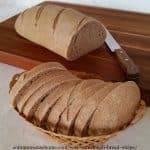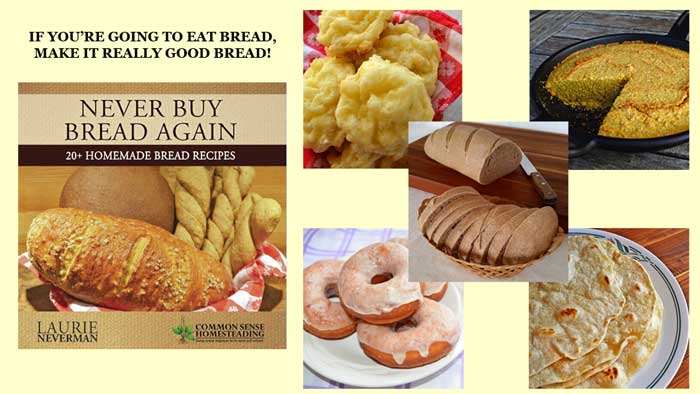Easy Sourdough Bread Recipe, Plus Sourdough Starter Tips
This easy sourdough bread recipe from starter can be made with your homegrown starter or a purchased sourdough starter. Whichever one you choose, make sure your starter is active before baking sourdough bread.
Real sourdough bread requires an active starter to raise, since you don’t add extra commercial yeast. Feed your sourdough starter 6-8 hours before bread baking. (Inactive starter can be used for recipes like sourdough cookies, crackers or brownies.)
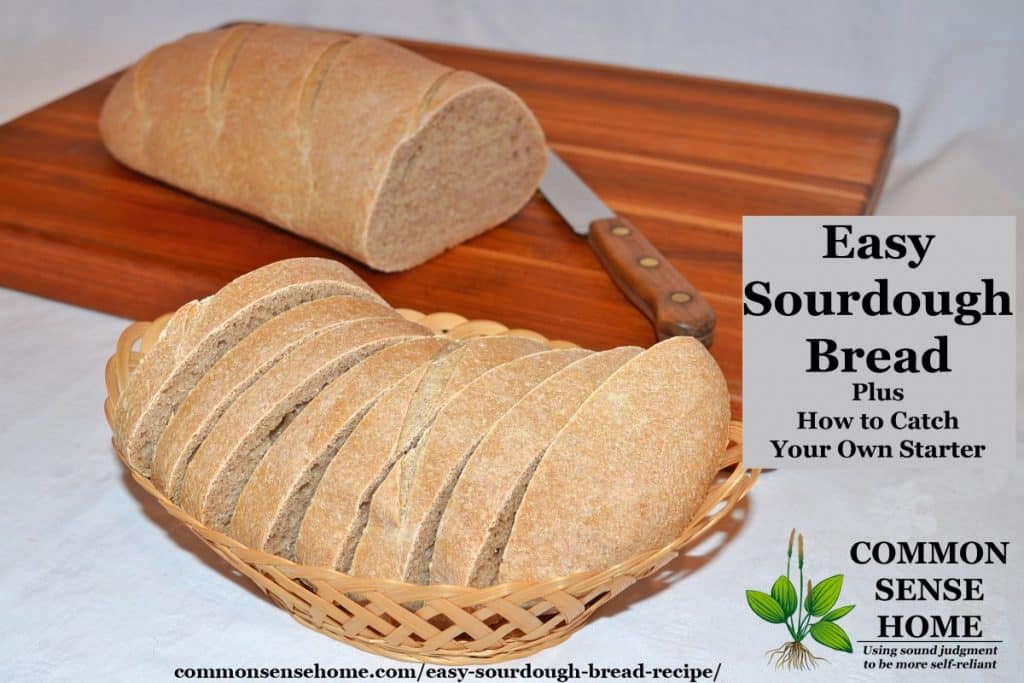
Buy Sourdough Starter or Grow Your Own Starter?
When I first made sourdough bread, I was nervous about cultivating my own starter. I heard a number of stories from friends who have had difficulty getting consistent results with their homegrown starters.
When I bake bread, I need bread (I knead bread, too, but that’s another story ;-). The loaves or rolls or whatever I’m making are part of our meal plan, and if they don’t bake correctly, it’s a problem.
I buy organic wheat berries and flours, and I can’t afford to be throwing out flopped loaves of bread. (I don’t think most of us can afford to throw away food, especially with rising food prices.) So, in the interest of successful sourdough right from the start, I bought a sourdough starter.
There are tons of sourdough starters available online, including:
- Alaskan Sourdough Starter (which I purchased)
- San Francisco Sourdough Starter
- Gluten Free Sourdough Starter
I took a break from sourdough for a time, and when I started working with it again, I made my own starter. The directions for creating a sourdough starter at at the bottom of the post.
PrintEasy Sourdough Bread
This easy four ingredient sourdough bread recipe makes a big, beautiful rustic loaf.
Ingredients
- 2 1/3 cups Fresh Sourdough Starter
- 3 1/3 cup Flour
- 1 – 1 1/2 cup Water (approximate)
- Scant Tablespoon Salt
Instructions
- Mix sourdough starter, flour and salt together. Use enough water to make bread dough (a moist dough is preferable to a dry dough). Knead dough until it passes the “window pane test” (a small piece of dough will stretch between four fingers thin enough to allow light to pass through without breaking).
- Shape the dough into a loaf . Place in a pan, proofing basket or on a board. Cover lightly with a towel and allow the dough to rise for 4-24 hours.
- If desired, a short (4-12 hours) proofing period can be used and the dough can be punched down, reshaped and allowed to rise a second time but a second proofing period is not required.
- Slice an “X” or slashes in the top of the loaf with a very sharp knife or razor blade. Bake at 400°F (205°C) until the internal temperature reaches 210°F (99°C). (Use a meat thermometer inserted into the bottom or side of the loaf to test the temperature).
- Bake 30-60 minutes (depending on loaf size). Allow the bread to cool before slicing.
Sourdough Bread Baking Notes
I made up my dough in my Bosch mixer. (After killing three bread machines, I decided to invest in something sturdier.)
It took over half an hour of kneading to get a nice “window pane” dough.
For my first loaf, I did a single rise after mixing. I eyed up the volume of dough that this recipe produced and decided to shape it into a single loaf and allow it to rise on a cookie sheet. Instead of an “x” on top, I made two parallel slices. This is important, as it gives the bread room to expand in the oven.
The loaf grew up HUGE! (You can see it took up most of a cookie sheet.) Inside, the texture was smooth and firm. The crust was appropriately chewy, but not tough, and it had a very mild sour flavor.

My youngest complained that it “tasted too much like store bread” (translation – all white flour is not normal for us).
So the next time I fed my starter, I gave it half fresh ground hard white wheat berries and half white bread flour. When I mixed the dough, I used the same ratios. This time I divided the dough in two parts and placed it in bread pans.
These loaves rose beautifully, too (and my youngest approved of the flavor).
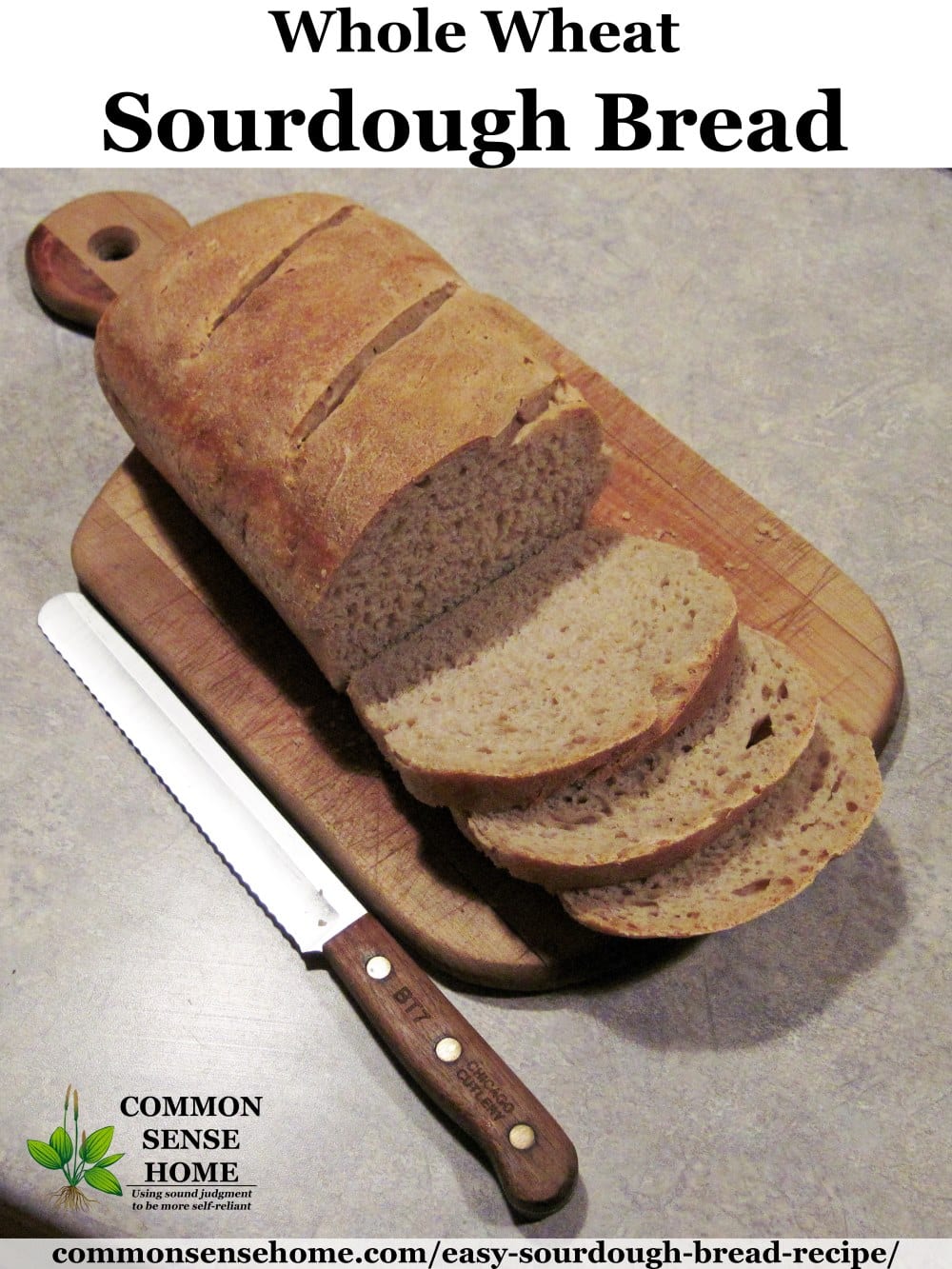
Bread Baking Books and Videos
Since these first loaves, I’ve ordered Wardee’s sourdough e-book and started experimenting with other recipes. Sourdough crackers are what we make the most, using her recipe base. I liked what she does so much I signed up as an affiliate. Wardee is the Queen of Sourdough and Fermented Foods, at least in my book. 🙂
You can get her Sourdough a to Z ebook, plus 5 videos and bonus recipe ebooklet for only $20. Learn more here. I’m a sourdough beginner, she’s a pro.
She also has an ebook and video series on baking with Einkorn flour. Einkorn is an ancient type of wheat that is lower in gluten and easier for some people to digest.
This recipe is also featured in my new book, “Never Buy Bread Again – 20+ Homemade Bread Recipes“.
This book will help you:
- Bake amazing homemade bread – even if you’ve never baked before!
- Avoid the preservatives and additives in commercial bread
- Learn how to store your fresh bread the right way to keep it fresh and delicious
- Save money by using basic pantry ingredients
- Make holidays extra special with homemade sweet breads like Gram Irene’s cinnamon rolls
Would you like to save this?
Now available in spiral bound print edition and digital formats here.
Easy Sourdough Bread Starter and Tips for Starter Use
To capture your own sourdough starter, start with whole grain wheat or rye flour and pure, unchlorinated water. Place about 4 ounces of flour (scant 1 cup) and 4 ounces (1/2 cup) warm water in a non-reactive vessel. Mix well.
You can use a wide mouth Mason jar, other glass, steel, crockery or food grade plastic. Your container should be around 4 cups in volume, as the starter will expand as it becomes active.
Cover the container with a coffee filter or flour sack towel secured to keep larger critters out. Place in a warm location such as near a stove or on top of the fridge. You can even use a heating pad if you like – just make sure it’s not too hot by placing a folded towel between the heat source and the starter.
Let sit 24 hours.
Day 2 with your sourdough starter
On day two, discard half of the starter mix. This can go into the compost. Add the same amount of flour (you make use white flour if you like) and water that you used on day one. Mix well, cover, and less rest another 24 hours.
Day 3 with your sourdough starter
By day three, you should be starting to see bubbles. Discard half the starter (or use it to make brownies, cookies, pancakes other baked goods that don’t require a very active starter.
To get your starter into high gear for bread baking, you should start feeding it twice a day, roughly 12 hours apart.
After about a week of feeding, your starter should bubble very actively and have a slightly sour aroma. The starter should roughly double in volume each time it is fed.
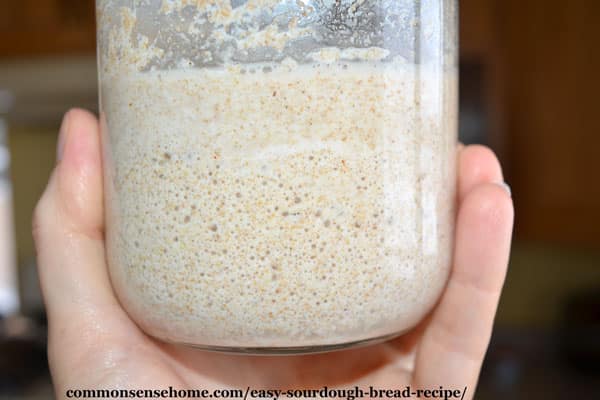
When the starter is ready, feed the starter and let it rest at room temperature for 6-8 hours before using in your recipe.
Storing and Using Your Sourdough Starter
To store your starter, place it in a loosely covered container in the refrigerator.
Note: It is best not to refrigerate your sourdough starter until it is at least a month old, because it will strengthen over time. The starter should be fed right before storage, and should be fed at least weekly to keep it healthy.
If you do a fair amount of baking/cooking with sourdough, keeping it out at room temp with regular feedings. (Feed your sourdough starter once a day for maintenance, twice a day when you need an active starter.)
Grinding Your Own Flour
I recommend the NutriMill Classic Grain Mill for grinding your own fresh flour. It’s compact, easy to use, and doesn’t heat up the flour like some other mills.
Is Sourdough Healthier Than Other Bread?
Maybe, maybe not. Every person is different, with a different microbiome. Some people do find sourdough easier to digest than breads made with commercial yeast. I haven’t personally noted a difference. Homemade bread of any type sits better in my belly than industrial bread with its long list of ingredients.
The study “Bread Affects Clinical Parameters and Induces Gut Microbiome-Associated Personal Glycemic Responses” notes:
We demonstrate statistically significant interpersonal variability in the glycemic response to different bread types, suggesting that the lack of phenotypic difference between the bread types stems from a person-specific effect.
We further show that the type of bread that induces the lower glycemic response in each person can be predicted based solely on microbiome data prior to the intervention.
Basically, sourdough bread spiked the blood sugar of about half the people in the test more than regular white bread, and the other half of people tested just the opposite.
Another study from the University of Guelph (The Acute Impact of Ingestion of Sourdough and Whole-Grain Breads on Blood Glucose, Insulin, and Incretins in Overweight and Obese Men) fed four different types of bread to overweight dudes, and found that sourdough breads had the most positive impact on glycemic response, specifically:
Insulin area under the curve (AUC) for sourdough and white was lower than 11-grain and sprouted-grain breads. GLP-1 response to sourdough was lower than all breads.
Note that this study worked with people who were already obese, where the other trial did not specifically recruit heavy volunteers. Pay attention to how you feel when you eat bread. Try different types (or going without) and see what works best for you.
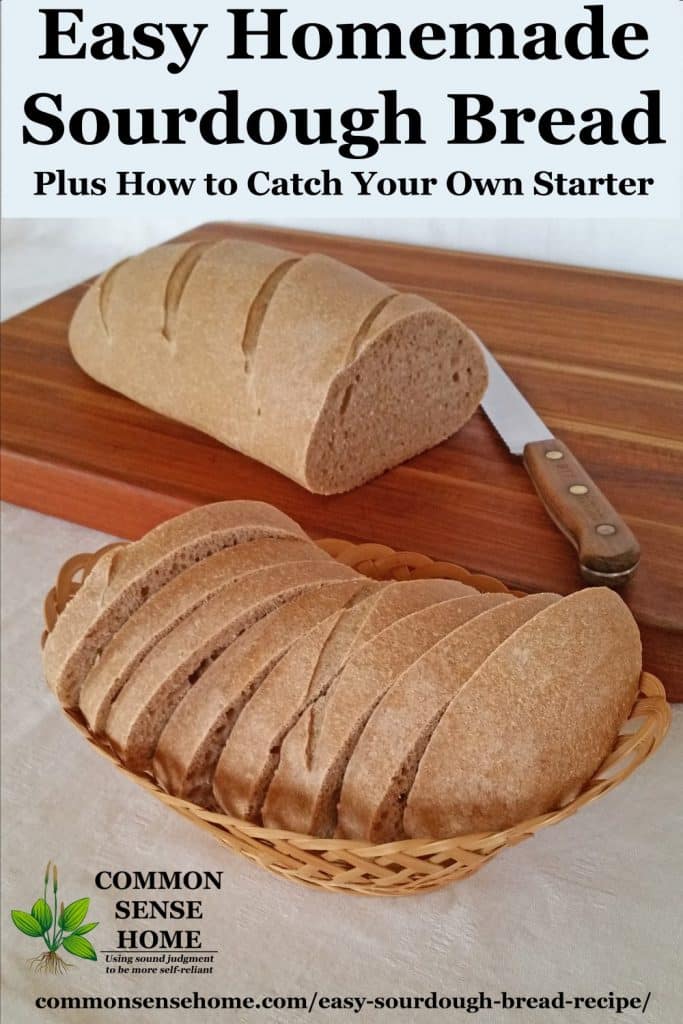
Originally posted in 2011, last updated in 2017.


